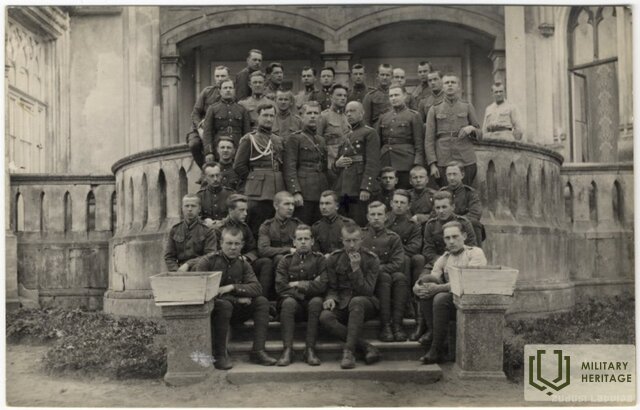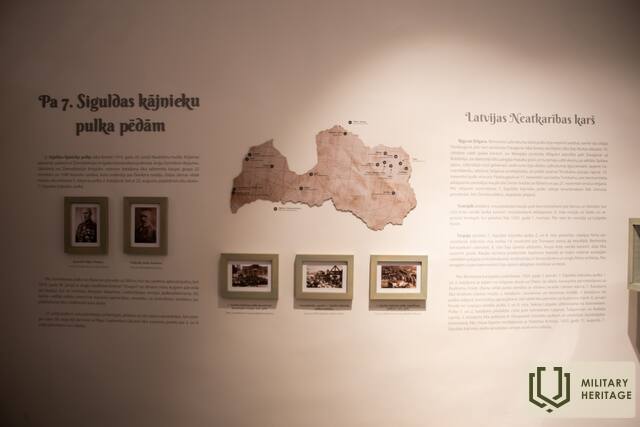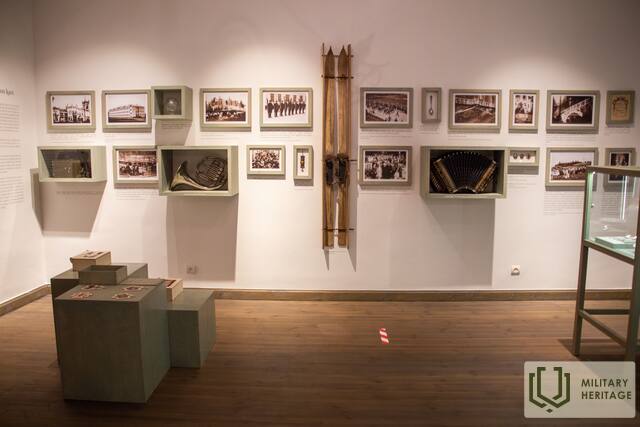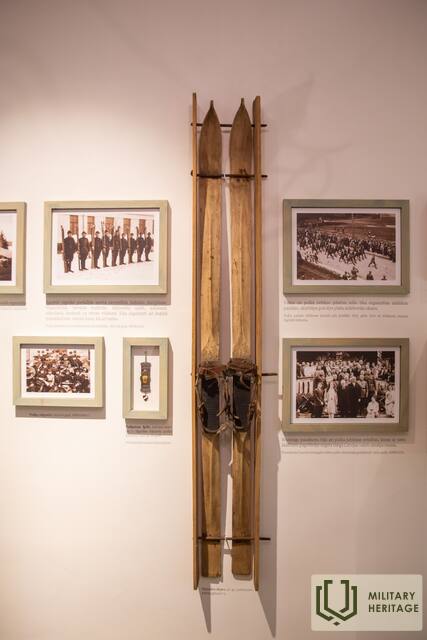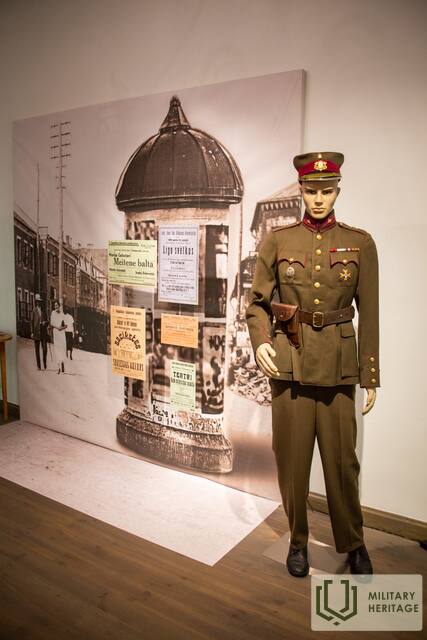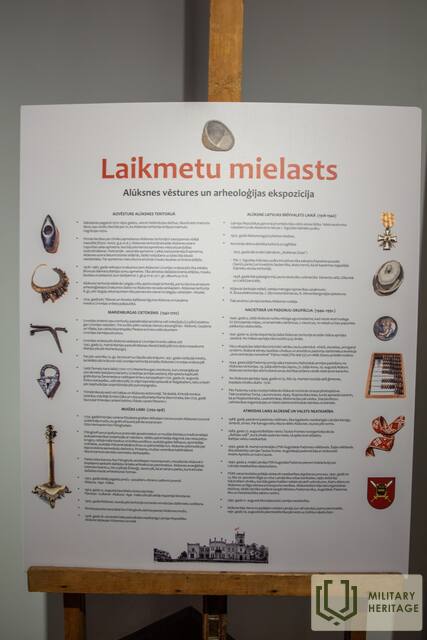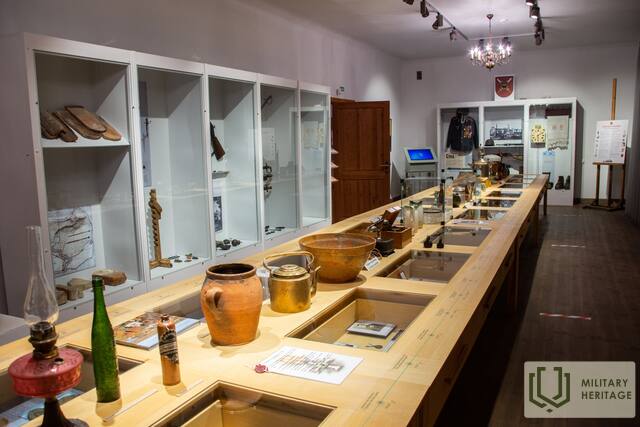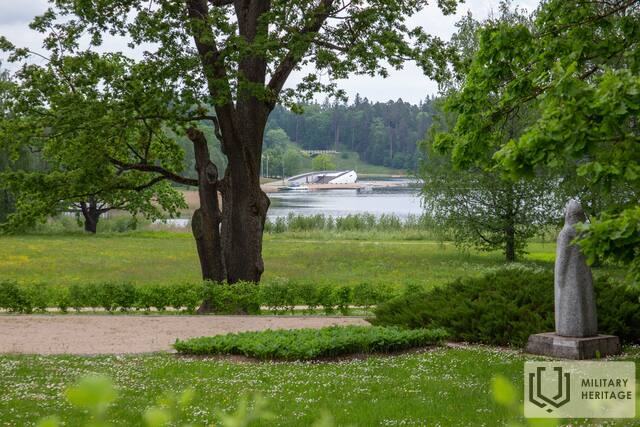Alūksnės muziejus Muziejus
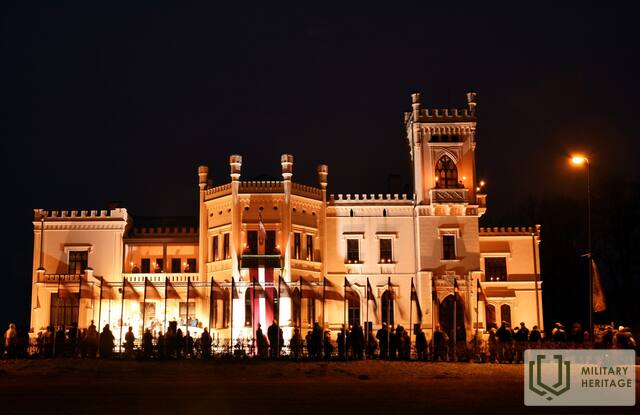

Alūksnės muziejus įsikūręs nacionalinės reikšmės architektūros paminkle – neogotikinėje Alūksnės Naujojoje pilyje, pastatytoje XIX a. pabaigoje. Muziejuje veikia paroda „Totalitarinio režimo aukų memorialinis kambarys“, kurioje pasakojama apie Alūksnės savivaldybės gyventojų likimus Sibire ir Tolimuosiuose Rytuose, o laikotarpis nuo priešistorės iki šių dienų susitinka Alūksnės istorijos ekspozicijoje „Amžių šventė“. Joje yra atskiras skyrius, skirtas 7-ojo Siguldos pėstininkų pulko indėliui į kariuomenę, kultūrą ir visuomenės gyvenimą. 7-ojo Siguldos pėstininkų pulko formavimas prasidėjo 1919 m. birželio 20 d. Naukšėnų dvare. Iš pradžių iš Šiaurės Latvijos brigados rezervinio bataliono buvo suformuota 22 karininkų ir 1580 kareivių kovinė grupė, pavadinta Dankersų divizija. Ji buvo įtraukta į 3-iojo Jelgavos pulko 2-ąjį batalioną. Rugpjūčio 23 d., padidėjus kuopų skaičiui, jis tapo 7-ojo Siguldos pėstininkų pulko dalimi. Dalyvavęs mūšiuose prieš Bermontą, 1920 m. sausio 5 d. pulkas buvo perkeltas į Latgalos frontą kovoti su bolševikais. Pasirašius taikos sutartį su Sovietų Rusija, pulkas saugojo rytinę Latvijos sieną. Latvijos nepriklausomybės kare žuvo daugiau nei 200 pulko karių, o 85 buvo apdovanoti Lačplėšio karo ordinu. 1921 m. 7-asis Siguldos pėstininkų pulkas buvo dislokuotas Alūksnėje. Pulko štabas buvo įsikūręs Alūksnės naujojoje pilyje. Po Antrojo pasaulinio karo pilį perėmė sovietų saugumo institucijos. Nuo šeštojo dešimtmečio pabaigos pilyje buvo įsikūrusios įvairios kultūros įstaigos: Vykdomojo komiteto Kultūros ir kinematografijos skyrius, pionierių namai, biblioteka, kino teatras ir muziejus.
Panaudoti šaltiniai ir literatūra:
Alūksnės turizmo informacijos centras
Edukacinės programos
Karinis paveldas Alūksnės krašto muziejuje
Alūksnės Naujojoje pilyje, kurioje kadaise buvo 7-asis Siguldos pėstininkų pulkas, dabar įsikūręs Alūksnės krašto muziejus, kuriame mokiniai parodose „Totalitarinio režimo aukų atminimo kambarys“, pasakojančiose apie Alūksnės krašto gyventojų likimus Sibire ir Tolimuosiuose Rytuose, sužinos apie Alūksnės istoriją ir kariuomenės vaidmenį jos augime, o Alūksnės istorijos parodoje „Amžių puota“ bus įdomu sužinoti, kaip susikerta laikotarpiai nuo priešistorės iki šių dienų. Atskiras skyrius skirtas 7-ojo Siguldos pėstininkų pulko indėliui į karinį, kultūrinį ir visuomeninį gyvenimą.
Teatro-edukacinis spektaklis su dalyvavimu „Penkios likimo istorijos“
Programa skatina mokinių supratimą apie sovietų valdžios vykdytus trėmimus, latvių gyvenimą tremtyje, pabrėžiant tautinio identiteto išsaugojimą ir trėmimų pasekmes Latvijos istorijos ir kultūros raidai. Pamokos metu mokiniai susipažins su penkių skirtingų personažų, patyrusių tremties įvykius, istorijomis. Muziejaus darbuotojai vaidins tremtinių vaikų istorijas, įtraukdami mokinius į pamokas. Griežtai prižiūrint Raudonosios armijos kareiviui, dalyviai turės rasti trūkstamus fragmentus represuotųjų dienoraščiuose, naršyti rusų kalba parašytame nuosprendyje, rasti užšifruotą tekstą, perskaityti jį veidrodiniu raštu, analizuoti fotografinę medžiagą ir ieškoti atsakymų į neaiškius klausimus. Deportacijų tragediją dar labiau sustiprino nepatogios darbo sąlygos, medžiagų trūkumas ir prieštaringi, besąlyginiai reikalavimai, už kurių nevykdymą deportacijų metu buvo baudžiama. Programos metu studentai mokosi įžvelgti, atrasti ir analizuoti priežastinius ryšius istoriniuose procesuose ir juos panaudoti socialiniams procesams paaiškinti. Ištirkite deportacijų metu įvykusius pokyčius ir padarykite išvadą, kaip jie susiję su politine padėtimi Latvijoje ir pasaulyje. Analizuoja veiksnius, darančius įtaką pokyčiams. Išmokite bendradarbiauti su bendraamžiais ir naudotis įvairiais informacijos šaltiniais. Programos metu studentai mokosi atpažinti ir siūlyti sprendimus situacijose, kai kyla grėsmė žmonių fiziniam ir emociniam saugumui, bei aptarti moralinius ir etinius gyvenimo vertės aspektus. Mokomasi įgūdžių demonstruoti elgesį, kuris išreiškia pagarbą ir asmeninę atsakomybę už savo ir kitų saugumą bei gerovę dviprasmiškose situacijose. Programos trukmė – 60 minučių. Tai taip pat galima rengti mokyklinių ekskursijų metu.
Susijusi laiko juosta
Susijusios temos
Susijusi istorija
7-oji Siguldos pėstininkų pulko bermontiada, Didžiosios kunigaikštienės Valijos Veščūnos apdovanojimas Lāčplės karo ordinu Alūksnėje.
Po Latvijos nepriklausomybės karo didžioji seržantė Valija Veščuna už mūšius su bermontininkais prie Plānių namų 1919 m. lapkričio 19 d. buvo apdovanota Lačplėsio karo ordinu. Valija Veščuna buvo viena pirmųjų, perėjusių Lielupės upę, apšaudyta priešo.
Apie Latvijos Nepriklausomybės karą ir 1918 m. įvykius Alūksnėje
1918 m., kai vokiečių kariuomenė įžengė į Alūksnę, Latvijos šaulių batalionai atsitraukė į Sovietų Rusiją. Iki 1918 m. gruodžio pradžios buvo įtvirtintas vokiečių režimas ir vykdomos reorganizacijos. Vokietijai kapituliavus kare, bolševikai grįžo į Alūksnę ir atkūrė savo valdžią. Suomijos savanoriai taip pat kovojo Estijos armijos sudėtyje Latvijos Nepriklausomybės kare. 1919 m. vasario 21 d. Alūksnėje, netoli stoties, vyko įnirtingi mūšiai tarp bolševikų ir Suomijos savanorių pulko „Šiaurės berniukai“.
7. Siguldos pėstininkų pulko formavimas
1919 m. birželio 20 d. Naukšėnų dvare, netoli Rūjienos, Šiaurės Latvijos brigados vado pulkininko Jorgio Zemitano įsakymu pradėtas formuoti 7-asis Siguldos pėstininkų pulkas. Iš pradžių iš Šiaurės Latvijos brigados rezervinio bataliono buvo suformuota nedidelė kovinė grupė, susidedanti iš 22 karininkų ir 1580 kareivių, kuri, pagerbiant pirmąjį vadą Oskarą Dankerį, buvo pavadinta Dankerio divizija. Po kelių dienų divizija buvo įtraukta į 3-iojo Jelgavos pulko 2-ąjį batalioną, o rugpjūčio 23 d., pridėjus kuopą, – į 7-ąjį Siguldos pėstininkų pulką.





